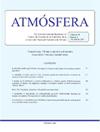评估东非和南部非洲网格化卫星和再分析降水产品的能力
IF 1
4区 地球科学
Q4 METEOROLOGY & ATMOSPHERIC SCIENCES
引用次数: 0
摘要
网格降水产品(GPP)的验证增加了用户的信心,并突出了处理复杂降雨过程的算法可能的改进。我们评估了三个GGPs (CHIRPS-v2、CHELSA和terrclimate)估算雨量计观测值的能力,并比较了这些产品在东非和南部非洲(ESA)地区的降水趋势。我们使用Taylor图和Kling-Gupta效率(KGE)来评估准确性。采用改进的Mann-Kendal检验和Sen ' s斜率估计分别确定趋势的显著性和幅度。3种gpp在时间和海拔上表现不同。在月尺度上,3个gpp的技能总体较高,但在海拔1500米以上表现较差,特别是在10 - 11 - 12月(OND)季节。三个gpp在1001 - 1500米海拔范围内表现同样良好。CHELSA-v2.1在0-500 mal海拔高度最准确,但在501 - 1000 mal海拔高度和1500 mal海拔高度以上的技能最低,这导致了对山地地形和大型内陆水体的年和季节降水趋势的高估。量化降水趋势显示出较高的时空变异性。总的来说,CHIRPS-v2和TC数据得出的技能和降水趋势除坦桑尼亚外显示出实质性的趋同。我们的研究结果强调了验证气候数据集的重要性,以避免在不同的模式和应用中误差传播。此外,我们证明了新的或更高分辨率的降水数据并不总是准确的,因为算法更新可能会引入伪影或偏差。本文章由计算机程序翻译,如有差异,请以英文原文为准。
Assessing the skill of gridded satellite and reanalysis precipitation products over in East and Southern Africa
Validation of gridded precipitation products (GPP) increases the users’ confidence and highlights possible improvements in the algorithms to handle complex rain-forming processes. We evaluated the skill of three GGPs (CHIRPS-v2, CHELSA, and TerraClimate) in estimating the rain gauge observations and compared the precipitation trends derived from these products across the East and Southern Africa (ESA) region. We used Taylor diagrams and Kling-Gupta Efficiency (KGE) to assess the accuracy. A modified Mann-Kendal test and a Sen’s slope estimator were utilized to determine the trends’ significance and magnitude, respectively. The three GPPs had varied performance over temporal and altitudinal ranges. The skill of the three GPPs, at a monthly scale, was generally high but showed lower performance at elevations over 1500 masl, especially during the October-November-December (OND) season. The three GPPs performed equally well between the 1001 – 1500 masl elevation range. CHELSA-v2.1 was most accurate at 0-500 masl but had the lowest skill in both 501 – 1000 and above 1500 masl elevations, which caused over-estimation of the annual and seasonal precipitation trends over mountainous terrain and large inland water bodies. The quantified precipitation trends revealed high spatial-temporal variability. Generally, the skill and precipitation trends derived from CHIRPS-v2 and TC data showed substantial convergence except in Tanzania. Our results emphasize the importance of validating climate datasets to avoid error propagation in different models and applications. Moreover, we demonstrate that new or higher-resolution precipitation data are not always accurate since an algorithm update can introduce artifacts or biases.
求助全文
通过发布文献求助,成功后即可免费获取论文全文。
去求助
来源期刊

Atmosfera
地学-气象与大气科学
CiteScore
2.20
自引率
0.00%
发文量
46
审稿时长
6 months
期刊介绍:
ATMÓSFERA seeks contributions on theoretical, basic, empirical and applied research in all the areas of atmospheric sciences, with emphasis on meteorology, climatology, aeronomy, physics, chemistry, and aerobiology. Interdisciplinary contributions are also accepted; especially those related with oceanography, hydrology, climate variability and change, ecology, forestry, glaciology, agriculture, environmental pollution, and other topics related to economy and society as they are affected by atmospheric hazards.
 求助内容:
求助内容: 应助结果提醒方式:
应助结果提醒方式:


